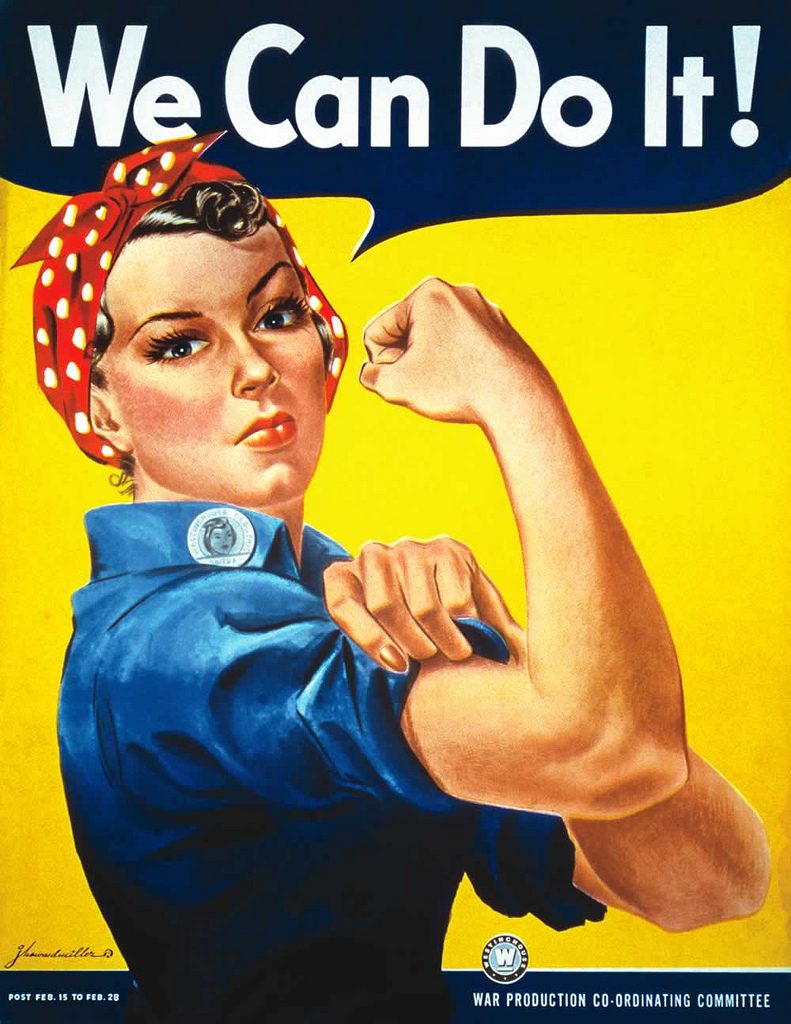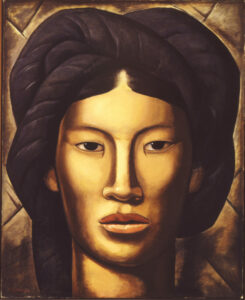From 1941 to 1945, during World War II, many woman were needed in the workplace because millions of men had joined the armed forces to fight in the European and the Pacific theaters of the war. In the Depression years just before this, women had been encouraged to stay at home, and let the men take the reduced number of manufacturing jobs available.1 With the onset of the war and the dramatically increased demand for manufactured wartime products, factories across the country opened their doors to women workers by the millions. In fact, there was a concerted effort to enlist women into the work force. In 1942, artist J. Howard Miller created the popular image of a woman named “Rosie the Riveter.” This poster was initially named, “We Can Do It!” and was made for the Westinghouse Electric and Manufacturing Company. Rosie was represented wearing makeup, a polka dot headband, and a rolled up sleeve shirt that portrayed strength and independence in women.2

Rosie the Riveter was a fictional character that many woman in the workforce identified with. The initial purpose of her image was to influence women to see themselves as capable of doing work previously thought to be men’s work. Her image combined beauty and strength, which is why many woman saw her as a role model. Even though Rosie the Riveter was a fictional character, her image was actually based on a photograph of a woman named Geraldine Doyle, who was a Michigan factory worker.3
There were some jobs that women took on that required training. Because of this, their wages were higher due to the fact that their jobs were more challenging and engaging compared to jobs that they may have had before. During the war, eighteen million women referred to themselves as being “Rosies.” Out of these eighteen million Rosies, six million had the opportunity to work for the first time. These women understood that the U.S. military and economy needed them; however, what motivated them to work was their own patriotism.4
In 1942, before Miller’s poster was created, Redd Evans and John Jacob Loeb wrote a song called, “Rosie the Riveter.” This hit song had lyrics that acknowledged and recognized the work that women did during the war:
All the day long whether rain or shine
She’s a part of the assembly line
She’s making history,
working for victory
Rosie the Riveter.
Keeps a sharp lookout for sabotage
Sitting up there on the fuselage
That little frail can do
more than a male will do
Rosie the Riveter.5
The song became associated with the existing images of Rosie the Riveter, which was a perfect blend of patriotism and beauty and strength in women.6
Unfortunately, after the war, the jobs and wages that Rosies had adapted to their lifestyles came to an end for the majority of them. Some went back to working “less challenging” jobs, and some became stay-at-home mothers. Because of this, birth rates increased, which led to the baby boom that lasted from 1946 through 1964. Even though many women went back to their previous lifestyles, they claimed to have left the workforce more confident and had more self-worth, knowing that they had proved to society that they were capable of doing men’s work.7
World War II changed the lifestyles of women significantly. Going from housewives to working in different industries allowed women to prove to society that this type of work was not just for men. There may have been no intention for women to prove themselves what they are capable of; however, women did leave their jobs after the war feeling better about themselves. Rosie the Riveter remains an iconic figure in American history, representing not only beauty in women, but also strength, courage, and confidence.
- Encyclopedia of Sex and Gender, 2007, s.v. “Rosie the Riveter,” by Susan L. Solomon. ↵
- America in the World, 1776 to the Present: A Supplement to the Dictionary of American History, 2016, s.v. “Rosie the Riveter,” by Nichola D. Gutgold. ↵
- Encyclopedia of Sex and Gender, 2007, s.v. “Rosie the Riveter,” by Susan L. Solomon. ↵
- Encyclopedia of Sex and Gender, 2007, s.v. “Rosie the Riveter,” by Susan L. Solomon. ↵
- Redd Evans and John Jacob Loeb, “Rosie the Riveter,” (New York: Paramount Music Corporation, 1942); The Four Vagabonds, “Rosie the Riveter,” recorded RCA Manufacturing Co., 1943. ↵
- America in the World, 1776 to the Present: A Supplement to the Dictionary of American History, 2016, s.v. “Rosie the Riveter,” by Nichola D. Gutgold. ↵
- Encyclopedia of Sex and Gender, 2007, s.v. “Rosie the Riveter,” by Susan L. Solomon. ↵



89 comments
Kimberly Rivera
Rosie the Riveter has always been in an important part of the United States history and women’s strength so it is great to see how inspiring the image alone was too many women back in the World War II era. The history behind it holds so much importance to how women were beginning to be perceived as and it is even more meaningful when I found out that even after leaving the workforce, women continued feeling powerful and confident in themselves. The article was great and I loved learning more about Rose the Riveter and her inspiring story.
Nadia Manitzas
As a female, Rosie the Riveter is seen as an idol for the “perfect blend of patriotism and beauty and strength in women.” She really gave women a sense of self importance and worth to fight for what we want in our lives. As time goes by she is still seen as an influence for American women to pursue their ideal lifestyle they want to live. Keep trying to find another point of view and find what inspires you to be the best women you can be.
Amanda Gutierrez
Excellent article! The image of Rosie the Riveter has always been around my whole life and I didn’t know the full story till now. It’s truly inspiring how she gave women the power they needed in unprecedented times. I really liked the song attached to this article, I had never heard it before. It’s amazing how the image is still empowering today. This was a great article and very well written!
Alondra Lozano
This was a really interesting and informative article. I had seen Rosie the Riveter pictures before, but never knew what it actually meant or what it led to. I can see how this figure became and icon, because it truly shows that women can attain anything by themselves. What also caught my eye was that this led to the baby boomer era. This was a great article!
David Castaneda Picon
Wow, I have seen the picture of Rosie the Riveter, that the author uses at the beginning of the story, several times before, but I did not know what was the meaning of it. I can see how this figure of Rise the Riveter became an icon, she is a symbol of strength, perseverance, and dedication among women. His figure can truly transmit that women are capable of doing anything they propose in life, and that they are just as capable as men of getting things done at the workplace. This was a well written article. I enjoyed learning about this figure and the meaning behind her.
Lesley Martinez
The famous image of Rosie the Riveter remains a significant figure to this day. This poster symbolizes the strength and beauty that women are capable of attaining. It’s interesting to read that women would refer to themselves as “Rosies” as a way to relate to Miller’s poster. It’s a great way to encourage individuals during times of war and boost the confidence of women in America. This is a great article!
Addie Piatz
I absolutely love the idea of Rosie the Riveter and how they were showing the strength in women during a time when women were not looked at like that in the slightest. If women did not step up during this time who knows what would have happened to our country. I feel like the symbol that Rosie was so impoering for women and really helped motivate them to make this country what it is today.
Felicia Stewart
Rosie the Riveter has been a significant icon all throughout my life. I can remember seeing pictures of her on the internet and when I saw her remembering that we can do anything and everything that we set out to achieve. She truly gave women the sense that they do not need to rely on men for everything that needs to be done, that they too can go out and do the same job and fix the same things. She helped erase the idea of a “mans job” to many females.
Alicia Guzman
What an icon and beacon of hope and perseverance for women. Rosie the Riveter is a symbol of the fact that we can do anything and everything. She has been not only a symbol to me growing up but to my mother and her mother, three generations of American women and learning the history and story of her in the article was great! Loved this article!
Rebeca Escobar
I would always see a poster of Rosie the Riveter in my art class at school. Reading the story behind her makes me realize how important her statement is and the impact she has had in women since World War II. She is especially empowering in the women’s march, as well. I’m happy that she’s a piece of history all women and young girls can be inspired by.